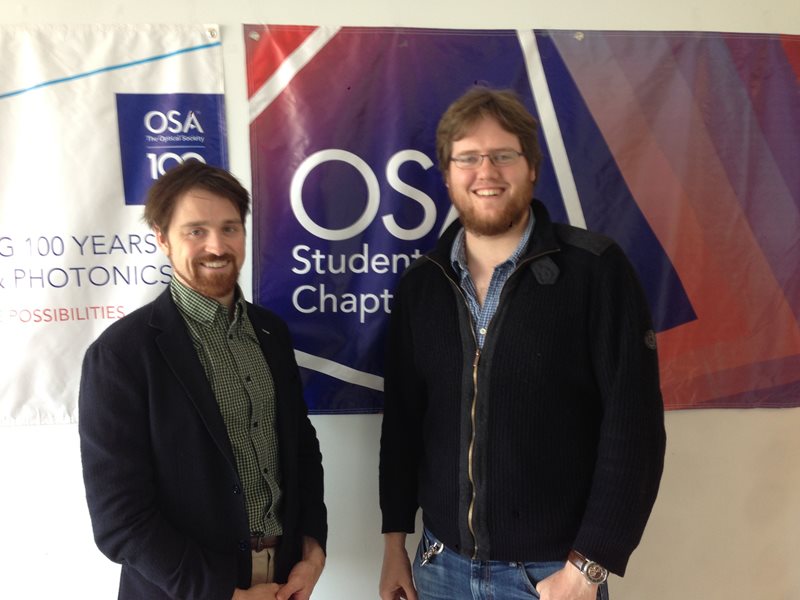Light Beyond the Lab: Putting Your Research Skills to Work
Light Beyond the Lab: Putting Your Research Skills to Work
Chad Husko, Argonne National Laboratory
Hey there!
This is the second in a series of blog posts I’m writing throughout 2016 in my role as OSA Ambassador. In case you missed my last post, you can find it here.
In this blog post I will discuss a recent trip across the border to Canada to attend the IONS-Quebec conference and to visit INRS-Montreal.
I’ll also give you a glimpse into some professional development pointers I’ve been sharing with the OSA community. In each new post I will comment on different aspects that appear in the live presentation. Today the topic will be ‘Communication skills.’ This is certainly à propos as this specifically came up in the talk of Jean Luc-Dumont (Principiae) at IONS-Quebec.

‘Light beyond the lab: putting your research skills to work’
In my last blog post, I talked about ‘Putting your PhD to work.’ If you missed that post, the goal I have set for this year is to communicate to optical scientists and engineers about the tremendous opportunities outside traditional career paths. The particular angle I am taking is how to translate scientific skills to more general job skills. Counterintuitively, the first step of the job hunt is not looking for a job, but rather to recognize our skills. Here is one example.
Communication skills
This one is seemingly obvious, perhaps a bit cliché, and certainly could fill many volumes. In this post, I will comment briefly on a few points.
First and foremost, science communication takes on many different forms:
- formal conference presentations to colleagues
- informal presentations to our groups
- public speaking to adults
- education outreach to students and children
- one-on-one mentoring to junior scientists
- documenting results in technical notes
- journal manuscripts
- grant writing to convince others of a new idea
- popular press to spread knowledge
- describing our research to our families and friends
- meeting with politicians to generate high-level interest in a topic
- speaking for video (television/internet)
All of these environments require slightly different styles of presentation and preparation. What’s great is that, as scientists, we employ all of these throughout our careers. Do an internet search for in-demand job skills. How many do you find that require or request communication skills? A lot.
My challenges to you
- Practice translating your work into a ‘one-sentence summary’ for a layperson.
- Learn to speak by analogy. Do you have an analogy to describe your work?
Water is a surprisingly efficient visual image that works well with many optics concepts.
Since our work is typically quite specialized, even talking to other scientists often requires translation into mutually intelligible language. These exercises will help you speak to everyone better about your work, and may even inspire you to take something from outside back into science.
If you forget the details of this post, the one overarching message I’d like you to remember is:
“Successful science requires successful communication.”
Now get out there and practice!”
Visit to INRS
All of a sudden I know a lot of scientists in Montreal, so INRS was an absolute must visit in 2016.
I was treated to a trio of hosts: Piotr Roztocki (OSA chapter president), Christian Reimer, and Professor Roberto Morandotti. Christian and I worked together when he was a visiting researcher at the University of Sydney. It was also great to connect with Young Zhang, a former PhD student, who is now here in Montreal. I presented two seminars, the first on ‘Putting the PhD to work’ from the professional development angle and a second on my technical research area ‘Nonlinear optics in nanophotonic waveguides.’ A number of impressive undergraduates made sure to come up and ask questions after the presentations. Questions are always a good sign so I’d call it a success.
IONS-Laval conference
After hearing for years about the IONS-Koala conference while working as a researcher at the University of Sydney, it was exciting to participate in IONS-Quebec as an Ambassador.
It’s worth mentioning that IONS grew out of a student initiative not too long ago and has quickly grown to multiple IONS events around the world. If you have a good idea, the OSA team is happy to listen and explore possibilities.
The quality of the presentations was very high and I was impressed by the number and depth of questions in the talks. Between sessions it was great to speak with so many people on an individual level and learn a lot of science. One of the biggest benefits of a smaller meeting is the opportunity to spend extended periods of time for deep understanding.
For social day, the organizers took us to a traditional ‘Sugar Shack’ where we learned how maple syrup is harvested and made. Growing up in a tree-covered part of the Midwestern US, I knew about maple trees, but never had seen a harvest. Did you know that 75% of the world production of maple comes from Quebec? If you’ve never had maple toffee, I highly recommend it. Yum!
UPCOMING EVENTS:
I’m looking to visiting with more OSA members at the upcoming OSA Latin American Optics and Photonics conference in Medellin, Colombia (August 22nd-25th). Fellow OSA Ambassador Alvaro Casas Bedoya and I are organizing a number of events. Medellin was the first city I visited outside my home country back in the year 2000 and I’m really looking forward to going back. If you have questions or specific sub-topics you’d like to discuss, please write me an e-mail.
If you happen to be at the OSA Photonics and Fiber Technology conference in Sydney, Australia (September 5th-8th), I will be speaking on the professional development topic described above. In addition to this, Alvaro and I will be hosting a social event for young professionals and students. Hope to see you there!
